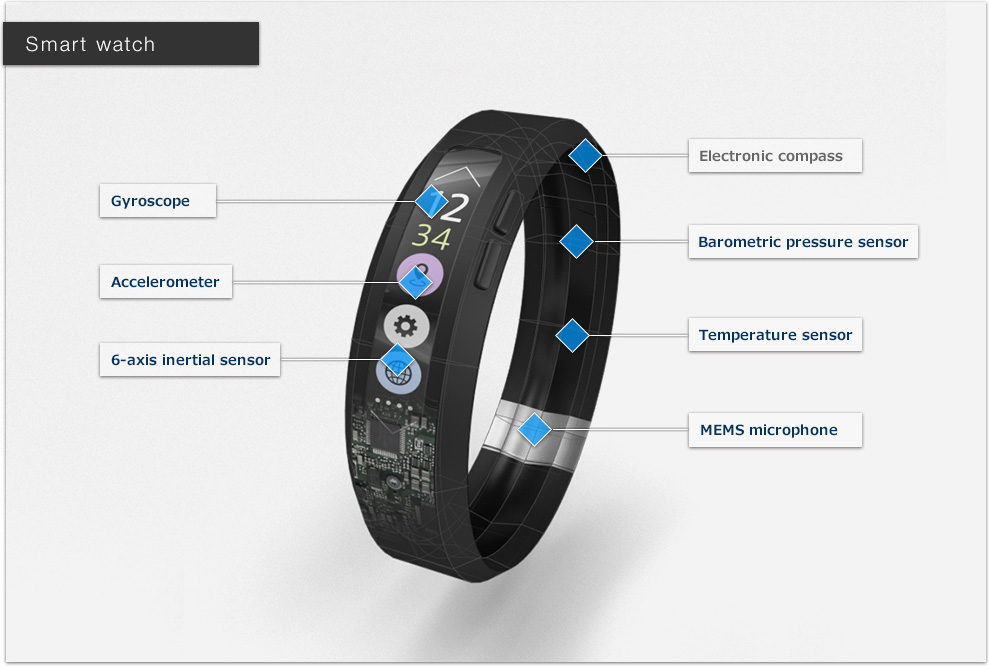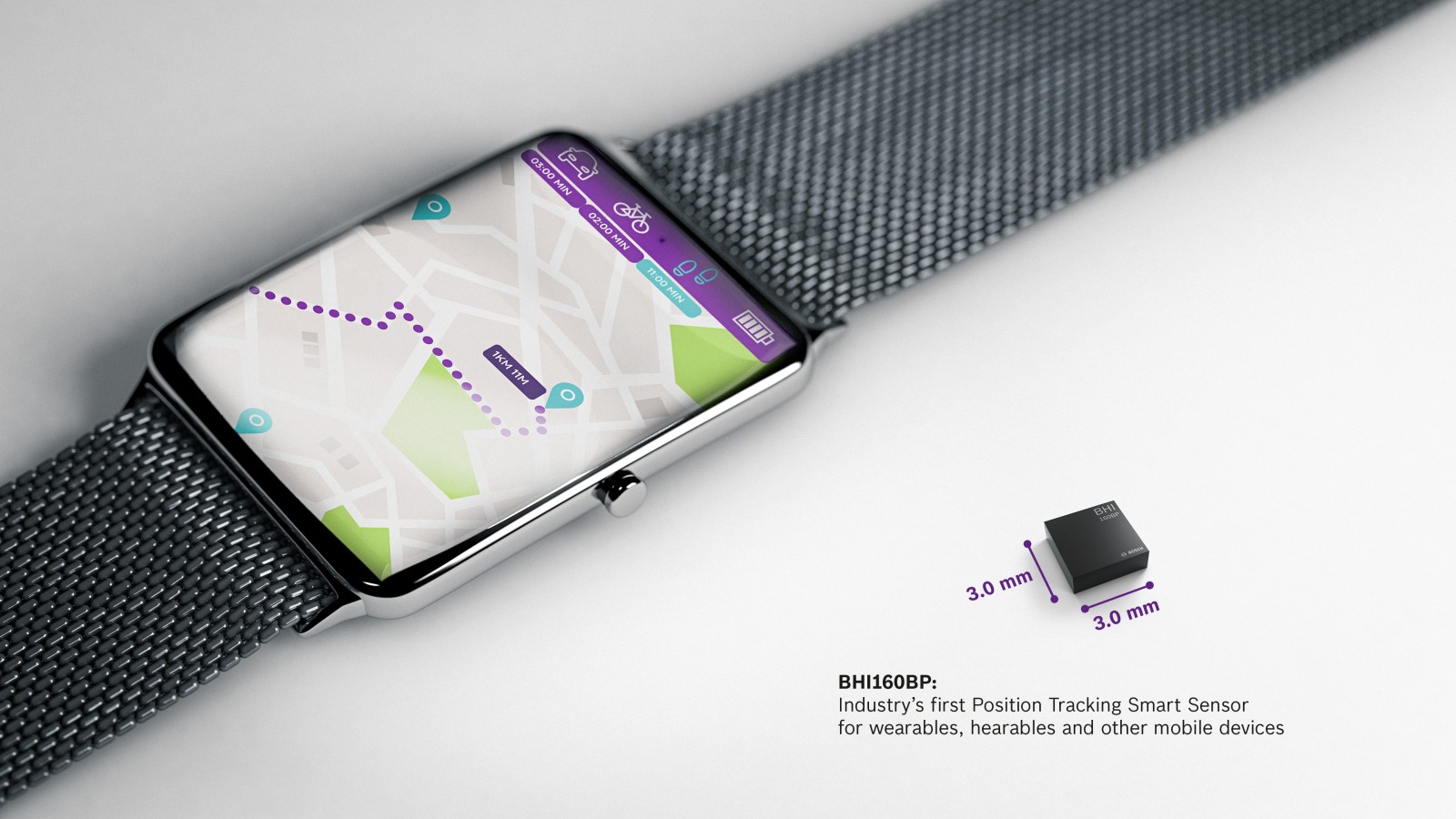By Majeed Ahmad, contributing writer
Wearable devices are a hotbed of sensors as well as a design conundrum due to size, power, and integration challenges. At the same time, however, major advancements in sensor and microelectromechanical (MEMS) technologies are reinvigorating the analog side with more accurate measurements and the digital front with more robust sensor fusion.
For a start, sensor miniaturization is a key driver for space-constrained wearable designs. For example, motion sensors are now available in tiny packages of 2 × 2 mm for fitness trackers, smartwatches, and hearables. And these compact sensors come integrated with plug-and-play functions like a step counter, so they can be easily incorporated even into clothes, jewelry, and watches.
Take the example of the ICM-20648, a six-axis motion tracking chip from TDK’s InvenSense operation, which comes integrated with a motion-sensing processor and software algorithm. That allows the wearable sensor IC to offer features such as a built-in activity classifier, calorie counter, and bring-to-see gesture tuned for wrist-worn wearables.

Fig. 1: Wearable devices like smartwatches will add more sensors to boost functionality and utility. (Image: TDK)
What’s also apparent is that wearables are commonly associated with activity-tracking devices such as fitness bands and sports watches. But many of these devices are so much more than simple monitoring gadgets. So there is a need for new types of sensors that can bring new functionalities to wearable devices. Take environment sensors, for instance, that can employ mapping applications to allow wearable devices to check the air quality and, thus, identify most polluted areas in a town.
Beyond fitness trackers
The demand for basic wristbands is waning, and at the same time, the market for wearable electronics in health care is quickly expanding, especially for personal health-monitoring devices such as smart patches and digital blood pressure monitors.
These wearable devices can monitor heart rate variability, oxygen levels, cardiac health, blood pressure, hemoglobin, glucose, and body temperature. Here, more sophisticated algorithms combined with sleek new sensors ensure that these health-care wearables are far more accurate for many medical use cases.
These types of medical wearables are not only a growing market; their focus on higher accuracy and greater performance also makes them less prone to price pressures that designers commonly face in consumer wearables. However, these medical designs face the challenge of long qualification periods. Here, validated and certified sensor modules come into play.
Take the case of a reference design for wearable devices providing 24/7 cuffless blood pressure measurement launched by the Premstaetten, Austria-based sensor supplier ams. It’s built around the AS7024 sensor chip and software that conducts blood pressure measurement, heart rate measurement (HRM), heart rate variability (HRV) monitoring, and electrocardiograms (ECG).
The AS7024 sensor chip includes three LEDs, photodiodes, an optical front end and sequencer for HRM, and an analog front end for ECG, a standard method for measuring the electrical pulses generated by the sinoatrial node. The sensor chip’s HRM operation is based on photoplethysmography (PPG), a technique that uses sampling light to measure the pulse rate in blood vessels, which expand and contract as blood pulses through them.
The accompanying software in this reference design analyzes the synchronized HRM and ECG measurements to calculate blood pressure. According to ams, the AS7024’s blood pressure measurements have been validated in a clinical trial at the Medical University of Graz in Austria as per IEEE standard for cuffless wearable devices.
Wearables’ power crunch
Power consumption, a crucial issue in portable electronics, becomes even more critical in wearable devices that mostly offer always-on detection and measurement functions. Moreover, wearable devices usually feature smaller-capacity batteries due to size constraints. Consequently, for sensing designs in wearable devices, engineers must choose between low power and high performance.
Therefore, sensor makers are now employing innovating new techniques to further lower the power draw from always-on sensors without performance and accuracy trade-offs. A new crop of solutions combines MEMS sensors with algorithms and firmware that intelligently process, synthesize, and calibrate the output of sensors.
A new position tracking sensor from Bosch Sensortec is a case in point. The BHI160BP sensor employs an algorithm for pedestrian dead reckoning (PDR) to calculate the user’s relative location based on data collected from the inertial sensor. Then it re-calibrates itself every few minutes to obtain the absolute position provided by the GNSS/GPS module.
In other words, the GNSS/GPS module, which can rapidly drain a device’s battery capacity, is kept in sleep mode for most of the time. That allows users to navigate reliably and extends GPS tracking in wearable devices from several hours up to several days.

Fig. 2: The always-on position tracking sensor is optimized for use with GPS/GNSS modules. (Image: Bosch Sensortec)
Another MEMS sensor from Bosch, the BMA400, claims to draw 10 times less current than existing accelerometers due to intelligent features like built-in activity recognition. It wakes up automatically only when it detects motion and goes back to sleep mode when the motion stops. The BMA400 accelerometer consumes 14 µA at the highest performance and falls to 1 µA and below in the ultra-low-power self-wake-up mode.
This acceleration sensor for wearable devices handles continuous measurement by using precisely defined cut-off frequencies. That, in turn, makes motion sensors resistant to vibrations, so wearable devices can distinguish between real alarm situations such as broken glass and false signals coming from random noise and vibrations.
Wearable sensors meet AI
What really makes wearables smart is artificial intelligence (AI), and that’s partly enabled by MEMS sensors featuring built-in local intelligence, which comes in the form of algorithms and software frameworks. These software solutions combined with hardware accelerators incorporate deep learning and other AI features to contextualize individual behaviors and surroundings. They independently process sensor data, and that also reduces power consumption, lowers cost, and boosts overall efficiency.
For example, the BMA400 accelerometer from Bosch mentioned in the above section integrates the motion classification functions. Bosch also offers smart sensor hubs, such as the BHI260 and BHA260 devices, which integrate MEMS sensors with a microcontroller for low-power sensor data processing and data buffering alongside a software framework that includes sensor fusion.
These low-power solutions incorporate data from multiple sensors and enable pre-processing for always-on execution. They facilitate features such as 3D orientation, step counting, position tracking, activity recognition, pose-and-head tracking, and context awareness in wrist-mounted products, hearables, eyewear, and other wearable devices.
Not surprisingly, therefore, software assets are becoming vital in the arsenal of MEMS sensor suppliers. It’s the algorithms and software frameworks that allow MEMS sensors to offer an accurate live classification of AI data and enable features like activity tracking without utilizing precious processor resources. It’s also a practical manifestation of the edge computing that has mostly been discussed in the context of IoT designs.
Summary
Wearable designers are building a whole new industry one gadget at a time, and MEMS sensors are an intrinsic part of this design movement. Wearable designs have come a long way from counting steps in fitness trackers, and they are already applying machine-learning algorithms to classify and analyze data.
New MEMS sensors are enabling this without requiring an external microcontroller, which cuts cost, lowers power usage, and reduces design complexity. Next, the symbiotic relationship between MEMS sensors and AI is expected to take wearable devices into a whole new space.
Advertisement
Learn more about Electronic Products Magazine





